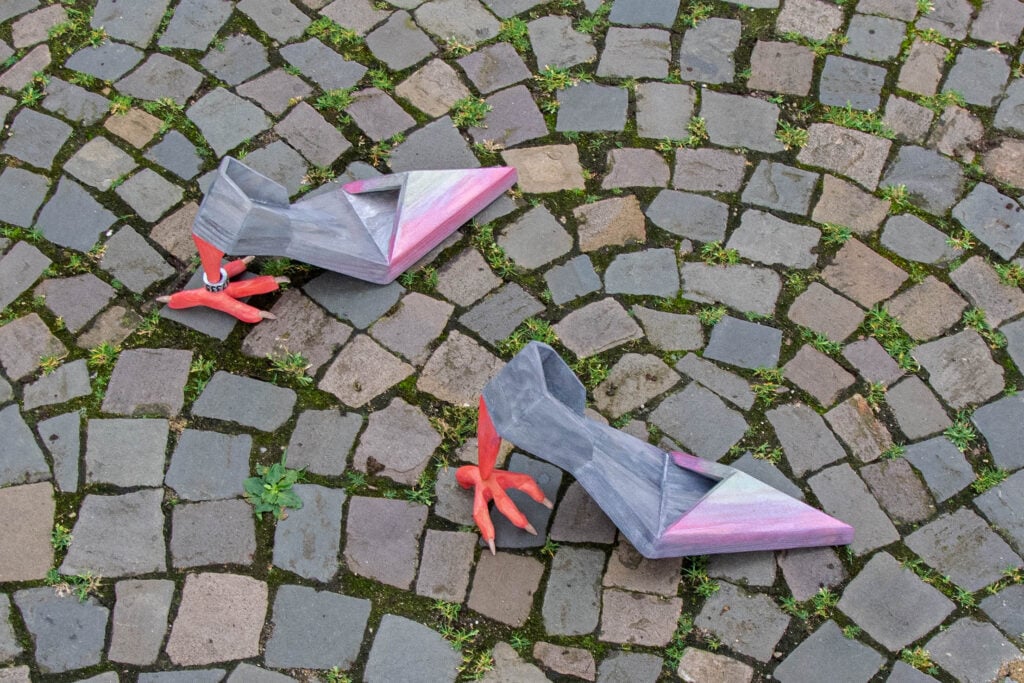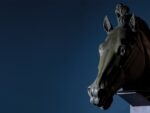Rike Droescher – Luci D. Dreams of Flying

Con Luci D. Dreams of Flying, tra ali di farfalla e uccelli estinti, tra miti e storie del passato, Rike Droescher reinventa e racconta con la scultura una favola antica quanto il mondo, quella dell’uomo e del suo desiderio di volare.
Comunicato stampa
Con Luci D. Dreams of Flying, tra ali di farfalla e uccelli estinti, tra miti e storie del passato, Rike Droescher reinventa e racconta con la scultura una favola antica quanto il mondo, quella dell’uomo e del suo desiderio di volare. L’artista sbircia tra le fratture e le crepe di un mondo antropocentrico, con una serie di opere che formano una costellazione di immagini di mondi che sconfinano l’uno nell’altro, forme di un’antropologia fantastica.
La mostra è concepita come una serie di sequenze del sogno di Luci D., un personaggio fittizio il cui nome crea, nella lingua inglese, un gioco di parole con lucid dream, sogno lucido. Dando forma alle visioni di Luci D., l’artista esplora diversi aspetti dell’archetipo del volo e degli uccelli, e intreccia una storia fatta di desideri, utopie e fantasie che si scontrano infine con il fallimento, la caduta, la perdita. Ciascuna opera agisce come un iper-testo poetico, al cui interno l’artista cela riferimenti o indizi per seguire Luci D. nel suo sogno, adottando il suo sguardo come nella soggettiva di un film. I titoli delle opere a loro volta orientano e scandiscono le ambientazioni del sogno, simili ad atti di una pièce teatrale.
L’opera Luci D. Dreams of Flying apre il racconto con dei calzari bizzarri, scarpe con un tacco a forma di zampa d’uccello. L’artista introduce così la fantasia zoomorfica e le ibridazioni fantastiche tra uomini e uccelli, reinterpretando una serie di immagini letterarie.
Scene from above: A cloud, a cuckoo, land porta Luci D. a Nubicuculia, città delle nuvole e dei cuculi dalla commedia greca di Aristofane, regno utopico nato da un accordo tra uomini e uccelli in cerca di una vita migliore tra il cielo e la terra. L’opera è come un letto di nuvole, su cui sono appoggiate riproduzioni in ceramica di pagine di giornale, smaltati e dipinti dall’artista, che riportano i suoni onomatopeici con cui i birdwatcher memorizzano e riconoscono il canto degli uccelli.
In Zenith: way over my head. How on earth could I fall? Luci D. incontra Icaro, o meglio quel che ne resta dopo la sua caduta: piume a terra e ali spezzate sono l’ultima traccia del folle tentativo di raggiungere il sole. In un lampo, lo scenario fantastico e la felice utopia di Nubicuculia si frantuma per ripiombare Luci D. sulla terra. Il sole più vicino è in realtà un lampione sulla strada. Qui, confuse e illuse, farfalle e falene muoiono. Droescher interrompe così il capitolo più immaginifico e visionario della storia creando una frizione tra la dimensione onirica e reale, tra illusione e disillusione. Look What I Have Done, Look What I Can Do (Recreation of Martha) segna un brusco ritorno alla realtà. La scultura è realizzata come un teatro delle ombre, con due mani a formare il profilo di un uccello. Attraverso l’espediente dell’ombra cinese, l’artista ironicamente veste i panni di un demiurgo: utilizzando gusci d’uovo polverizzati e una fonte luminosa, Droescher riesuma e riproduce artificialmente Martha, l’ultimo esemplare di Ectopistes migratorius (piccione migratore) morto nel 1914 presso lo zoo di Cincinnati.
Si dice che nel sogno lucido il sognatore sia consapevole del sogno, che tutto sia più vivido, che leggi della gravità vengano infrante: trasformarsi, scomparire, volare, il tutto-possibile nello spazio tra il sonno e la veglia. Rike Droescher esplora la libertà di questo spazio manipolando forme e materiali della natura, concependo ogni opera come una poesia o un racconto dal finale aperto.
–––––––––––––––––
Rike Droescher (1990) vive e lavora a Düsseldorf, dove nel 2020 si laurea presso la Kunstakademie. Tra le mostre personali e bipersonali: 2023, The Serpent’s Tail, con Zoe Koke, Alice Amati, Londra; Since The First Branch In The Hand, Atelier am Eck, Düsseldorf; 2022, If You Call Me I Won’t Be Home, Palatului Mogosoaia, Bucharest, The Big Murmur, Moltkerei Werkstatt, Cologne; 2021, Participation Trophy - Mur Brut, Kunsthalle Dusseldorf, Dusseldorf . Ha esposto in mostre collettive presso: Kunsthaus Essen, Essen (2023); Muzeul National al Hartilor si Cartii Vechi, Bucharest (2022); Fuhrwerkswaage, Cologne (2022); K21 Kunstsammlung Nordrhein-Westfalen, Dusseldorf (2021); Tiroler Landesmuseum Ferdinandeum, Innsbruck (2021) and Goethe-Institut de Paris, Paris (2017). Nel 2022 ha ricevuto l’ Art Award for Sculpture Diaconia Michaelshoven a Colonia; nel 2023 partecipa alla Bronner Residency a Tel Aviv.
Con il supporto di Alice Amati, Londra
ENG:
In Luci D. Dreams of Flying, amidst butterfly wings and extinct birds, myths and stories from the past, Rike Droescher reinvents and narrates a tale as ancient as the world: the human desire to fly. She delves into the fissures and cracks of an anthropocentric world, with her works emerging as a constellation of images intruding into one another, as remnants of a fantastical anthropology.
The exhibition unfolds as a sequence of Luci D.'s dream. By shaping into tangible form the visions of this fictional character, the artist explores the multifaceted bird-flight archetype and weaves a narrative of desires, utopias, and fantasies ultimately colliding with failure, fall, and loss. Each work acts as a poetic hyper-text, where the artist hides references or clues to follow Luci D. through her dream, adopting her perspective akin to a movie’s point-of-view shot. The titles of the works themselves serve as guide for the multiple scenarios of Luci’s dream, as if marking the acts of a theatre performance.
The work Luci D. Dreams of Flying opens the story with bizarre footwear — shoes with heels shaped like bird claws. Through this, the artist engages with a zoomorphic fantasy and imaginary hybridizations between humans and birds, reinterpreting a series of literary references.
Scene from Above: A Cloud, a Cuckoo, Land transports Luci D. to Cloud-cuckoo-land, the city of clouds and birds from Aristophanes' Greek comedy, founded on an agreement between humans and birds seeking a better life between sky and earth. The work resembles a bed of clouds, upon which are placed ceramic reproductions of newspaper pages glazed and printed by the artist with transcription of the sounds used by birdwatchers to memorize and recognize bird songs.
In Zenith: Way Over My Head. How on Earth Could I Fall?, Luci D. meets Icarus, or rather what remains of him after his fall: feathers on the ground and broken wings are the last traces of the reckless attempt to reach the sun. In a flash, the fantastical scenario and the peaceful utopia of Cloud-cuckoo-land shatter, bringing Luci D. back to earth. Here, streetlamps are the sun. Here, butterflies and moths perish, confused and deceived. Droescher interrupts the more imaginative chapter of the story, creating a friction between the dream and reality, illusion and disillusionment. Look What I Have Done, Look What I Can Do (Recreation of Martha) marks a harsh return to reality. The sculpture functions as a shadow theater, with two hands forming the profile of a bird. Through the art of shadow play, the artist ironically assumes the role of a demiurge: employing eggshell powder and light, she evokes and artificially reproduces Martha, the last known passenger pigeon of its species, which died in 1914 at the Cincinnati Zoo.
It is said that in a lucid dream, the dreamers are aware that they’re dreaming, that everything is more vivid and the laws of gravity are defied: transformation and metamorphosis, disappearance and flight, everything is possible within the space between sleep and wakefulness. Rike Droescher explores the freedom of this space by manipulating forms and materials from nature, and conceiving each sculpture as a poem or a story with an open ending.
–––––––––––––––––
Rike Droescher (b.1990) lives and works in Dusseldorf (DE). She graduated in 2020 from the Kunstakademie Düsseldorf, Solo and duo exhibitions include: 2023, The Serpent’s Tail, with Zoe Koke, Alice Amati, London; Since The First Branch In The Hand, Atelier am Eck, Düsseldorf; 2022, If You Call Me I Won’t Be Home, Palatului Mogosoaia, Bucharest, The Big Murmur, Moltkerei Werkstatt, Cologne; 2021, Participation Trophy - Mur Brut, Kunsthalle Dusseldorf, Dusseldorf. Her work featured in group exhibitions at Kunsthaus Essen, Essen (2023); Muzeul National al Hartilor si Cartii Vechi, Bucharest (2022); Fuhrwerkswaage, Cologne (2022); K21 Kunstsammlung Nordrhein-Westfalen, Dusseldorf (2021); Tiroler Landesmuseum Ferdinandeum, Innsbruck (2021) and Goethe-Institut de Paris, Paris (2017), amongst others. She is the recipient of the Art Award for Sculpture of Diaconia Michaelshoven Cologne (2022) and was awarded the Bronner Residency in Tel Aviv (2023).
Supported by Alice Amati, London



